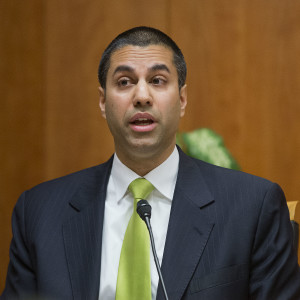One of the two Federal Communications Commissioners to vote against the agency’s plan to add Internet to Lifeline, the subsidized “ObamaPhone” program, is extending a “fiscally responsible” comprise to commissioners ahead of a final vote Thursday.
“Modernizing the FCC’s Lifeline program to support affordable, high-speed Internet access for our nation’s poorest families is a worthy goal,” FCC Commissioner Ajit Pai said Wednesday. “But failing to clean up the waste, fraud, and abuse in the program puts the entire enterprise in jeopardy.”
Earlier this month FCC Chairman Tom Wheeler dropped his plan to update Lifeline, which is designed to provide low-income Americans with a $9.25 monthly subsidy to help pay for the cost of telephone service. Under the new plan, consumers can apply the subsidy to broadband Internet service — a move the agency hopes will spur providers to offer bundled service plans for phone and Internet.
The proposal also ups the budget from $1.6 billion to $2.25 billion in an effort to reach more eligible enrollees, calls for the establishment of a “National Eligibility Verifier” to tackle the fraud and abuse that have plagued the program in recent years and puts in place a budget mechanism to notify the commission when it reaches a certain threshold.
According to Pai — who with lone Republican colleague Commissioner Michael O’Rielly voted against updating Lifeline last summer — those measures aren’t enough to protect American consumers, who pay for Lifeline with fees included on their monthly telephone bills, accumulating in the FCC’s Universal Service Fund.
“That’s why I’ve proposed to my colleagues a compromise to update the Lifeline program in a fiscally responsible way,” Pai said.
The Republican commissioner’s plan would reduce the Lifeline budget increase to $1.75 billion, enough to offer Internet access “to every single Lifeline-qualifying household” not online today, while maintaining landline voice service.
According to the FCC some 40 million Americans currently fall within the income threshold to apply for the subsidy, with only 32 percent — or about 13 million — currently enrolled.
It also establishes a budget mechanism of a different type, which instead of notifying the commission and promoting them to take action when it reaches 90 percent, reduces payments to carriers automatically when the estimated costs of the program would exceed the budget.
“As Senator Claire McCaskill recently wrote us, a mechanism must ‘prevent a repeat of the unchecked increase in spending that was seen the last time the program was expanded,'” Pai said. “My proposal would do just that without denying any eligible consumer a Lifeline subsidy.”
Shortly after Lifeline was expanded to include wireless service, the program’s budget rose an average of more than 25 percent per year from $821 million in 2008 to $2.1 billion in 2012.
Part of the rise in cost came from widespread fraud and abuse from consumers to wireless providers. The FCC reported 41 percent of the program’s six million-plus subscribers in 2012 failed to provide eligibility documentation, with many subscribers enrolling multiple times with falsified information to get a free cellphone along with the subsidy.
At the same time, several small wireless providers were caught enrolling the same customers multiple times for profit, prompting the FCC to implement reforms in 2012 including a database to prevent duplicate enrollees and fining cheating providers $96 million for negligence and fraud. As a result the budget was reduced in 2014 to its current $1.6 million.
Pai’s proposal also proposes to raise the minimum service standards in Wheeler’s plan from the minimum of 10 megabits-per-second download speeds to 25 Mbps for fixed broadband and from 3G to 4G LTE for mobile broadband.
“As Chairman Wheeler has put it, these speeds are ‘table stakes’ for digital consumers in the 21st century,” Pai said. “I believe low-income families and students deserve a seat at the table.”
Though Pai’s plan sets the bar more in line with the commission’s overall service standards, Democrats on the commission worry setting the standards higher could prompt providers to set higher minimum monthly payments, forcing subscribers to pay out-of-pocket to make up the difference.
The plan also does away with an enhanced $25 monthly subsidy in counties with more than 50 people per square mile, which Pai said “was intended to support the construction of facilities in Indian Country, but has instead encouraged abuse of the program in large cities … and suburban communities.”
Wheeler is unlikely to adopt the last-minute compromise ahead of the vote to implement the changes during the FCC’s March open meeting Thursday. During a congressional hearing last week Pai pointed out there have been twice as many party-line votes at the FCC since December 2013, one month after Wheeler became chairman, than during the previous four chairmanships combined.
The Republican commissioner testified during an earlier hearing the process at the FCC under Wheeler routinely leaves Pai and O’Rielly “in the dark,” while the remaining three Democratic commissioners develop proposals without Republican input.
Growing partisanship at the commission has not gone unnoticed by Congress, where lawmakers — including House Energy and Commerce Communications and Technology Subcommittee Chairman Greg Walden — have been seeking to update the commission’s rulemaking procedure and transparency.
“I believe true reforms require changes in law that can transcend any particular chairman or commission,” Walden said last week. “Unfortunately, sharp divisions within the commission are widely known.”

